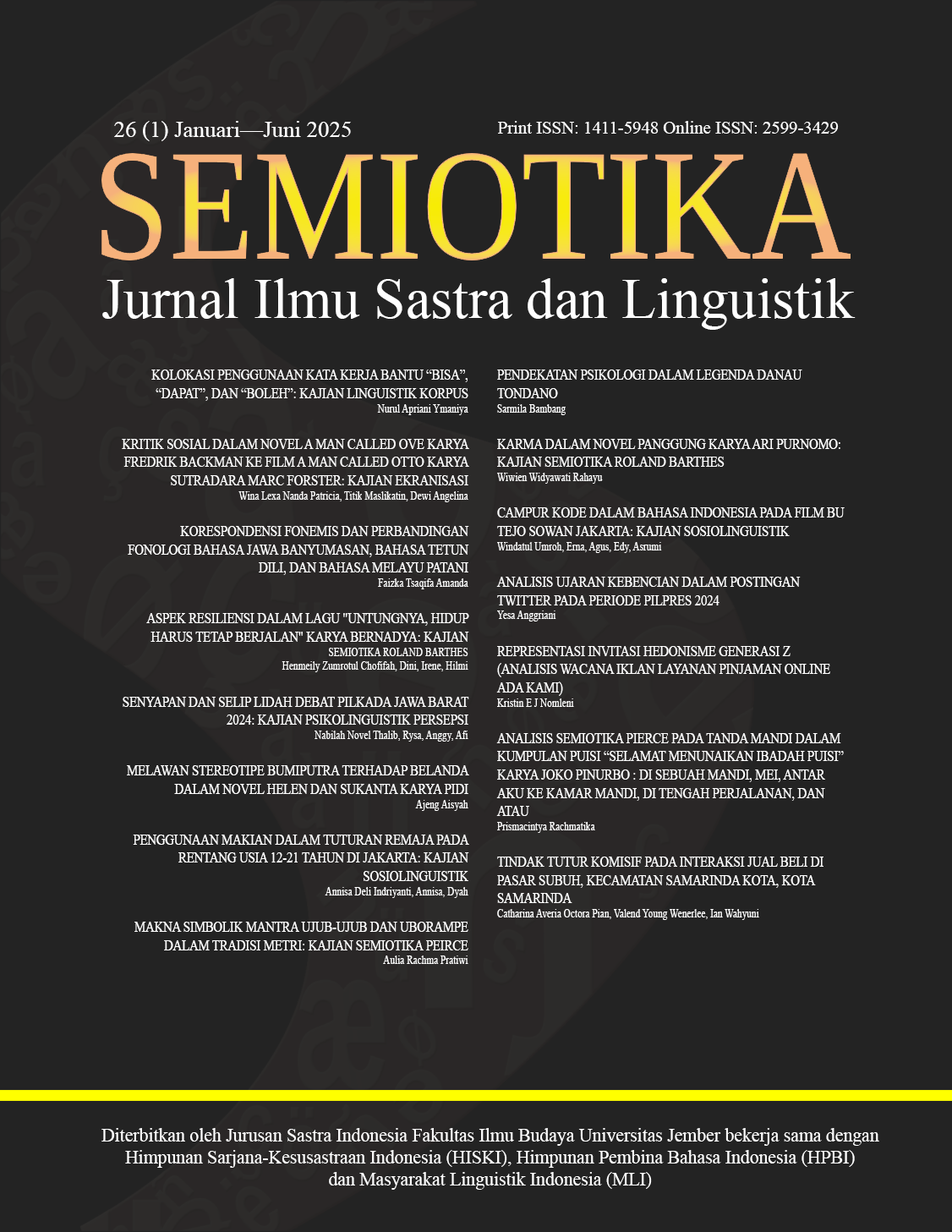KOLOKASI PENGGUNAAN KATA KERJA BANTU “BISA”, “DAPAT”, DAN “BOLEH”: KAJIAN LINGUISTIK KORPUS
DOI:
https://doi.org/10.19184/semiotika.v26i1.49892Keywords:
korpus, linguistics, verbAbstract
This study aims to (1) identify the frequency of use of the words "bisa", "dapat", and "boleh" using the frequency of occurrence of Concordance and Collocation; and (2) compare the use and meaning of the words "bisa", "dapat", and "boleh" using the LCC Indonesia 2023 Corpus approach and collocation. The study was conducted by combining qualitative and quantitative methods. The results of the study show the following findings. First, the frequency of occurrence in the corpus of the word "bisa" reached 2,463,773/million words; the word "dapat" reached 1,858,449/million words; and the word "boleh" reached 145,184/million words; based on the last three years (2020-2022). Second, based on the comparison of the use and meaning of the words "bisa", "dapat", and "boleh" shows that the use of the word "bisa" gets more attention in its use with the meaning of the word juxtaposed with other words; producing sentences with the form of a person's ability or expertise possessed by an individual. The word "dapat" based on the use and meaning of the word, tends to express the possibility or opportunity for something. The word “boleh†based on the use and meaning of the word, shows the conflict between refusal and permission.
Downloads
References
Al-Rasyeed, A.B. 2023. “Kolokasi pada Kata ‘halloween’ di Awal Abad ke-20 dan ke-21: Analisis Berbasis Korpus”. Jurnal Multidisiplin West Science, 2(1):39—47. doi:https://doi.org/10.58812/jmws.v2i1.123.
Barker, M. 1992. In Other Words: a Course Book on Translation. New York: Routledge.
Barker, P., Hardie, A., & McEnery, T. 2006. A Glassy of Corpus Linguistics. Edinburgh: Endinburgh University Press.
Budiawan, dkk. 2024. “Kolokasi pada Kata ‘Cinta’ Berbasis Linguistik Korpus”. Jurnal Pendidikan Bahasa dan Sastra Indonesia, 12(1):186—195. doi:https://doi.org/10.26877/sasindo.v12i1.18419.
Islamiyah, M., & Sholakhuddin, M. 2019. “Skinny, Slim, dan Thin: Berbasis Korpus Kata Sifat Identik dan Implikasinya pada Pengajaran Berbahasa Inggris”. Jurnal Ranah, 8(1):19—32. doi:https://doi.org/10.26499/rnh.v8i1.894.
Krisnawati. 2023. “Analisis Kolokasi Verba Bahasa Inggris Berbasis Korpus dalam Novel Five Feet Apart”. Jurnal Ilmiah Multidisiplin Amsir, 2(1):199—132. doi:https://doi.org/10.62861/jimat%20amsir.v2i1.331.
Lirong, Z. 2022. “Studi Berbasis Korpus: Perbandingan Kolokasi dan Prosodi Semantik Sinonim Berbahasa Indonesia ‘Menyebabkan’ dan ‘Mengakibatkan’”. Jurnal Mabasan, 16(1):153—176. doi:https://doi.org/10.26499/mab.v16i1.517.
Logar, M., Gantar, P., & Kosem I. 2014. “Colocation and Examples of Use: Alexical Semantic Approach to Terminology”. Jurnal Slovenščina 2.0, 2(1):41—61. doi:ttps://doi.org/10.4312/slo2.0.2014.1.41-61.
Marks, J., & Wooder A. 2007. Check Your Vocabulary for Natural English Collocation. London: A&C Black Publisher Ltd.
Putrayasa, I., & Susandhika, I. 2022. “Kolokasi Bahasa Bali: Kajian Semantik”. Prosoding Seminar Bahasa Sastra & Budaya, Vol. 1:78—87.
Setyaningsih, N., Larassati, A., & Suryaningtyas, V. W. 2021. “Kolokasi Leksikon Covid-19 dalam Bahasa Indonesia dan Bahasa Inggris di Ranah Cyberspace”. Jurnal Humanika, 28(2):186—198. doi:https://doi.org/10.14710/humanika.v28i2.40600.
Sudja’ie, M. A., Purwandari, G.H., & Sari, R.P. 2018. “Ketidaklaziman Diksi dalam Kolokasi Leksikal (Tipe Verb+Noun dan Tipe Adjectiva+Noun)”. Jurnal Ilmiah Lingua Idea, 9(1):29—34. doi:http://jos.unsoed.ac.id/index.php/jli/article/view/316.
Sulistyowati, R. 2023. “Kolokasi Leksikon Bernuasa Negatif terhadap Program Pemerintah: Studi Kasus Media Sosial Instagram”. Jurnal Mlangun Ilmiah Kebahasaan & Kesastraan, 20(2):143—158. doi:https://jurnalmlangun.kemdikbud.go.id/ojs2022/index.php/mlangun/article/view/92.
Downloads
Published
Issue
Section
License
Copyright (c) 2025 Semiotika: Jurnal Ilmu Sastra dan Linguistik

This work is licensed under a Creative Commons Attribution-ShareAlike 4.0 International License.
SEMIOTIKA has CC-BY-SA or an equivalent license as the optimal license for the publication, distribution, use, and reuse of scholarly work. Authors who publish with this journal retain copyright and grant the journal right of first publication with the work simultaneously licensed under a Creative Commons Attribution-ShareAlike 4.0 International License that allows others to share the work with an acknowledgment of the work's authorship and initial publication in this journal.
Attribution-ShareAlike
CC BY-SA


